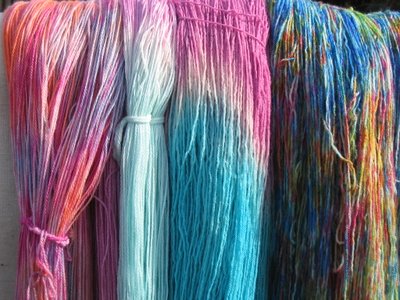 Top Picture: Tencel/Merino on the left and BFL Ultra! on right after curing, washing, drying. Since the Tencel/Merino is a blend of a cellulose fiber (which dyes up with fiber reactive dyes) and a protein fiber (which dyes up with acid dyes), I did an experiment using both types of dyes. The two yarns on the right side are the BFL Ultra! which is a protein fiber and were dyed with acid wash dyes. (If you click on this picture to enlarge it, you will see the silky sheen in the Tencel/Merino."
Top Picture: Tencel/Merino on the left and BFL Ultra! on right after curing, washing, drying. Since the Tencel/Merino is a blend of a cellulose fiber (which dyes up with fiber reactive dyes) and a protein fiber (which dyes up with acid dyes), I did an experiment using both types of dyes. The two yarns on the right side are the BFL Ultra! which is a protein fiber and were dyed with acid wash dyes. (If you click on this picture to enlarge it, you will see the silky sheen in the Tencel/Merino."The multi colored yarn on the far left (Tencel/Merino) was dyed with fiber reactive dyes, using urea as the mordant. The Tencel/Merino two-color skein, which is second from the left, was dyed with acid wash dye, using white vinegar as the mordant.
 In an experiment like this, I tried to come up with dye solutions of equal intensity so that if there were a difference in dye absorption, it would show up easily. In the middle picture, the two-toned skeins are shown: BFL Ultra! in the inside curve, and Tencel/Merino in the outside curve. The turquoise did not absorb as well on the Tencel/Merino; the purple/rose absorbed about equally.
In an experiment like this, I tried to come up with dye solutions of equal intensity so that if there were a difference in dye absorption, it would show up easily. In the middle picture, the two-toned skeins are shown: BFL Ultra! in the inside curve, and Tencel/Merino in the outside curve. The turquoise did not absorb as well on the Tencel/Merino; the purple/rose absorbed about equally.
This is a picture of the BFL Ultra! before being steamed. It shows a rawness to the color absorption which disappears entirely once the skein is wrapped and steamed. BFL Ultra! takes color beautifully, blooms just a bit to make a nice, round yarn, too.
It is the Tencel/Merino blend which will require some decisions when you are ready to dye it. Looking at the top picture, you'll notice that the result for this yarn, on the far left, is a muted and lovely color combo. This skein cured for about 6 hours before being rinsed out. The fiber reactive dyes released quite a bit of color, the reds especially, but the end result was so muted and beautiful, that I might forgive the additional work required to get to the result.
The turquoise and purple skein of Tencel/Merino did not release much of the acid dye at all, and the colors were not as vibrant as with the wool yarn.
Conclusion: BFL Ultra! takes acid dye beautifully. No problem, beautiful results.
Tencel/Merino can be dyed with either acid or fiber reactive dyes. In either case, one of the fibers will not absorb the dye and the rinsing bath will show a release of dye. This yarn yields muted blends of color, very beautiful and almost shimmery in appearance.
Both yarns are available, but just not yet posted on the website. They're coming, I promise. In the meantime, email me to order:
BFL Ultra! $ 23.20 for 8 oz skein, $ 46.40 for l-lb cone (1900 yards/lb)
Tencel/Merino $10 for 400 yard skein (1650 yards/lb)


